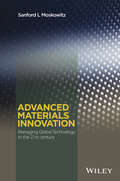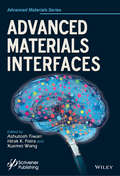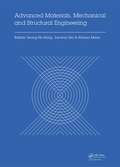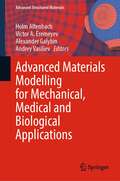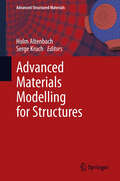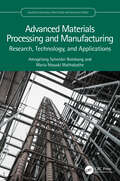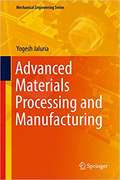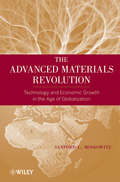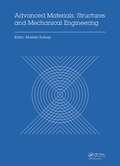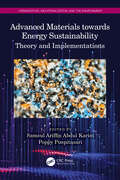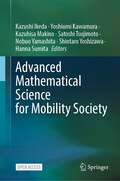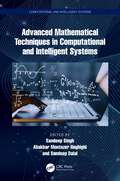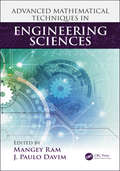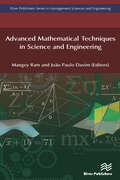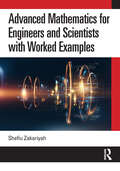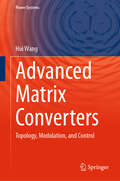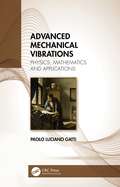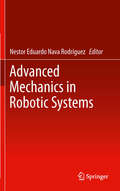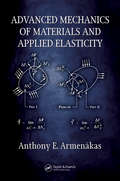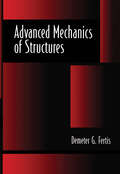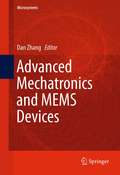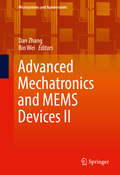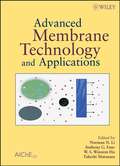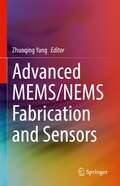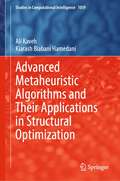- Table View
- List View
Advanced Materials Innovation: Managing Global Technology in the 21st century
by Sanford L. MoskowitzThrough detailed case studies of the most important advanced material creations of the latter 20th and early 21st century, the author explores the role of the field of advanced materials in the technological and economic activity today, with implications to the innovation process in general. A comprehensive study that encompasses the three major categories of advanced material technologies, i.e., Structural Materials (metals and polymers), Functional Materials (transistor, microchip and semiconductor laser) and Hybrid and New Forms of Matter (liquid crystals and nanomaterials). Extensive use of primary sources, including unpublished interviews with the scientists, engineers, and entrepreneurs on the front lines of advanced materials creation Original approach to case study narrative, emphasizing interaction between the advanced material process, perceived risk and directing and accelerating breakthrough technology
Advanced Materials Interfaces
by Hirak K. Patra Ashutosh Tiwari Xuemei WangAdvanced Material Interfaces is a state-of-the-art look at innovative methodologies and strategies adopted for interfaces and their applications. The 13 chapters are written by eminent researchers not only elaborate complex interfaces fashioned of solids, liquids, and gases, but also ensures cross-disciplinary mixture and blends of physics, chemistry, materials science, engineering and life sciences. Advanced interfaces operate fundamental roles in essentially all integrated devices. It is therefore of the utmost urgency to focus on how newly-discovered fundamental constituents and interfacial progressions can be materialized and used for precise purposes. Interfaces are associated in wide multiplicity of application spectrum from chemical catalysis to drug functions and the advancement is funnelled by fine-tuning of our fundamental understanding of the interface effects.
Advanced Materials, Mechanical and Structural Engineering: Proceedings of the 2nd International Conference of Advanced Materials, Mechanical and Structural Engineering (AMMSE 2015), Je-ju Island, South Korea, September 18-20, 2015
by Seung Ho Hong Junwon Seo Kihoon MoonIn the last decades, advanced materials and mechanics has become a hot topic in engineering. Recent trends show that the application of nanotechnology and environmental science together with advanced materials and mechanics are playing an increasingly important role in engineering applications. For catching up with this current trend, this boo
Advanced Materials Modelling for Mechanical, Medical and Biological Applications (Advanced Structured Materials #155)
by Holm Altenbach Victor A. Eremeyev Alexander Galybin Andrey VasilievThe book is devoted to the 70th birthday of Prof. Sergey M. Aizikovich, which will celebrated on August 2nd 2021. His scientific interests are related to the following topics: Mechanics of contact interactions, Functionally graded materials, Mechanics of fracture, Integral equations of mathematical physics, Inverse problems of the theory of elasticity, and Applications of elasticity to biological and medical problems of mechanics of materials. The papers, collected in the book, are contributions of authors from 10 countries.
Advanced Materials Modelling for Structures: With Multi-scale Effects Or Under Multi-field Actions (Advanced Structured Materials #19)
by Holm Altenbach Serge KruchThis volume presents the major outcome of the IUTAM symposium on "Advanced Materials Modeling for Structures". It discusses advances in high temperature materials research, and also to provides a discussion the new horizon of this fundamental field of applied mechanics. The topics cover a large domain of research but place a particular emphasis on multiscale approaches at several length scales applied to non linear and heterogeneous materials. Discussions of new approaches are emphasised from various related disciplines, including metal physics, micromechanics, mathematical and computational mechanics.
Advanced Materials Processing and Manufacturing: Research, Technology, and Applications (Advanced Materials Processing and Manufacturing)
by Amogelang Sylvester Bolokang Maria Ntsoaki MathabatheThis book describes the operations and industrial processes related to the production of advanced materials including ingot and powder metallurgy processing routes. It outlines the deformation processing mechanisms inducing failure at both ambient and high temperatures. Further, it embodies practical knowledge and engineering mechanisms of traditional and unorthodox material disposal approaches, concurrently with gear cutting/ manufacturing and computer numerically controlled machining. The surface fusion of metals in the production of coatings via the process of laser cladding is also covered. Features: Covers novel and multi-variety techniques of materials processing and manufacturing. Reports on the significant variables of the processes and basic operations of advanced materials. Discusses fundamental and engineering machining analysis. Includes novel fabrication of TiAl alloys using both powder and ingot metallurgy routes. Enables critical thinking through technical problem solving of local service manufacturers. This book is aimed at researchers and graduate students in materials and manufacturing engineering.
Advanced Materials Processing and Manufacturing (Mechanical Engineering)
by Yogesh JaluriaFocuses on new and advanced methods of manufacturing and materials processing with traditional methods described in light of the new approaches.<P><P> Maximizes reader understanding of the fundamentals of how materials change, what transport processes are involved, and how these can be simulated and optimized - concepts not covered elsewhere.<P> Introduces new materials and applications in manufacturing and summarizes traditional processing methods, such as heat treatment, extrusion, casting, injection molding, and bonding, to show how they have evolved and how they could be used for meeting the challenges that we face today<P>This book focuses on advanced processing of new and emerging materials, and advanced manufacturing systems based on thermal transport and fluid flow. It examines recent areas of considerable growth in new and emerging manufacturing techniques and materials, such as fiber optics, manufacture of electronic components, polymeric and composite materials, alloys, microscale components, and new devices and applications. The book includes analysis, mathematical modeling, numerical simulation and experimental study of processes for prediction, design and optimization. It discusses the link between the characteristics of the final product and the basic transport mechanisms and provides a foundation for the study of a wide range of manufacturing processes.
The Advanced Materials Revolution: Technology and Economic Growth in the Age of Globalization
by Sanford L. MoskowitzA comprehensive treatment of the economic and global impacts of the advanced materials industry This book represents the first comprehensive investigation of the emerging international advanced materials industry and its profound impact on the world's industrialized and newly emerging economies. It examines the ways in which science, technology, business, and markets have converged to produce one of the most dynamic industries in recent years—one that is increasingly controlling global technological progress as a whole. From the unique vantage point of this crucial industry, this book illuminates the major differences in how the world's two economic superpowers—the United States and the European Union—perceive and carry forward the technology creation process and what these differences mean for achieving national and regional competitive advantage in the twenty-first century. It draws upon a rich body of source materials spanning from 1970 through 2007 as well as actual in-depth interviews and internal corporate and governmental documentation. The book is organized thematically, with each section highlighting critical perspectives on the rise of the international advanced materials industry and its impact on the relative competitiveness of the United States and the European Union. It concludes with a discussion of how what we have learned about advanced materials in the West tells us of the future competitive power of an emerging Asia. The Advanced Materials Revolution is essential reading for researchers, executives, and managers working in the advanced materials and related technological fields, as well as professionals and scholars in the academic, investment, consulting, and government communities. It also serves as a valuable case study textbook for advanced undergraduate and graduate courses in business, management, entrepreneurship, technology studies, chemical and materials engineering, economics, economic history, and regional and economic development.
Advanced Materials, Structures and Mechanical Engineering: Proceedings of the International Conference on Advanced Materials, Structures and Mechanical Engineering, Incheon, South Korea, May 29-31, 2015
by Mosbeh KaloopThe International Conference on Advanced Materials, Structures and Mechanical Engineering 2015 (ICAMSME 2015) was held on May 29-31, Incheon, South-Korea. The conference was attended by scientists, scholars, engineers and students from universities, research institutes and industries all around the world to present ongoing research activities. This
Advanced Materials towards Energy Sustainability: Theory and Implementations (Urbanization, Industrialization, and the Environment)
by Samsul Ariffin Abdul Karim Poppy PuspitasariIndustry 4.0 is revolutionizing the way companies manufacture, improve, and distribute their products. It demands the application of renewable energy using advanced materials. Renewable energy is reshaping the fields of industry, agriculture, and households, providing reliable power supplies and fuel diversification. This enhances energy security, lowers the risk of fuel spills, and reduces the need for imported fuels. Examples of material applications used for renewable energy are photovoltaic, solar cells, which can be used in agriculture. This volume has a diverse audience including students, researchers, and academics engaged in materials and renewable energy. Features : Presents latest research on renewable energy in relation to urbanization, industrialization, and the environment. Provides in-depth discussion on modeling and simulation using latest techniques. Provides technical exposure for the readers on advanced materials. Provides numerous examples on properties of biomaterials and their future prospect. Provides up-to-date information on functional materials for industrial application.
Advanced Mathematical Science for Mobility Society
by Kazushi Ikeda Yoshiumi Kawamura Kazuhisa Makino Satoshi Tsujimoto Nobuo Yamashita Shintaro Yoshizawa Hanna SumitaThis open access book presents the mathematical methods for huge data and network analysis.The automotive industry has made steady progress in technological innovations under the names of Connected Autonomous-Shared-Electric (CASE) and Mobility as a Service (MaaS). Needless to say, mathematics and informatics are important to support such innovations. As the concept of cars and movement itself is diversifying, they are indispensable for grasping the essence of the future mobility society and building the foundation for the next generation. Based on this idea, Research unit named "Advanced Mathematical Science for Mobility Society" was established at Kyoto University as a base for envisioning a future mobility society in collaboration with researchers led by Toyota Motor Corporation and Kyoto University.This book contains three main contents.1. Mathematical models of flow2. Mathematical methodsfor huge data and network analysis3. Algorithm for mobility societyThe first one discusses mathematical models of pedestrian and traffic flow, as they are important for preventing accidents and achieving efficient transportation. The authors mainly focus on global dynamics caused by the interaction of particles. The authors discuss many-body particle systems in terms of geometry and box-ball systems. The second one consists of four chapters and deals with mathematical technologies for handling huge data related to mobility from the viewpoints of machine learning, numerical analysis, and statistical physics, which also includes blockchain techniques. Finally, the authors discuss algorithmic issues on mobility society. By making use of car-sharing service as an example of mobility systems, the authors consider how to construct and analyze algorithms for mobility system from viewpoints of control, optimization, and AI.
Advanced Mathematical Techniques in Computational and Intelligent Systems (Computational and Intelligent Systems)
by Sandeep Singh Aliakbar Montazer Haghighi Sandeep DalalThis book comprehensively discusses the modeling of real-world industrial problems and innovative optimization techniques such as heuristics, finite methods, operation research techniques, intelligent algorithms, and agent- based methods. Discusses advanced techniques such as key cell, Mobius inversion, and zero suffix techniques to find initial feasible solutions to optimization problems. Provides a useful guide toward the development of a sustainable model for disaster management. Presents optimized hybrid block method techniques to solve mathematical problems existing in the industries. Covers mathematical techniques such as Laplace transformation, stochastic process, and differential techniques related to reliability theory. Highlights application on smart agriculture, smart healthcare, techniques for disaster management, and smart manufacturing. Advanced Mathematical Techniques in Computational and Intelligent Systems is primarily written for graduate and senior undergraduate students, as well as academic researchers in electrical engineering, electronics and communications engineering, computer engineering, and mathematics.
Advanced Mathematical Techniques in Engineering Sciences (Science, Technology, and Management)
by J. Davim Mangey RamThe goal of this book is to publish the latest mathematical techniques, research, and developments in engineering. This book includes a comprehensive range of mathematics applied in engineering areas for different tasks. Various mathematical tools, techniques, strategies, and methods in engineering applications are covered in each chapter. Mathematical techniques are the strength of engineering sciences and form the common foundation of all novel disciplines within the field. Advanced Mathematical Techniques in Engineering Sciences provides an ample range of mathematical tools and techniques applied across various fields of engineering sciences. Using this book, engineers will gain a greater understanding of the practical applications of mathematics in engineering sciences. Features Covers the mathematical techniques applied in engineering sciences Focuses on the latest research in the field of engineering applications Provides insights on an international and transnational scale Offers new studies and research in modeling and simulation
Advanced Mathematical Techniques in Science and Engineering
by Mangey Ram; Joãao Paulo DavimIn recent years, mathematical techniques applied to novel disciplines within the science and engineering have experienced extraordinary growth. Advanced Mathematical Techniques in Science and Engineering focusses on a detailed range of mathematics applied within various fields of science and engineering for different tasks. Topics of focus include:- Analysis of Consensus-Building Time in Social Groups- Modeling of intersystem accidents in critical infrastructure systems- Stochastic approaches to analysis and modeling of multi-sources and big data- Performance evaluation of computational DoS attack on access point in Wireless LANs- Ranking methods for decision-making under uncertainty- Understanding time delay based Modeling & Diffusion of technological products- Role of soft computing in science and engineering- Complex system reliability analysis and optimization- Tree growth models in forest ecosystems modellingThis research book can be used as a reference for students in a final year undergraduate engineering course, such as mechanical, mechatronics, industrial, computer science, information technology, etc. Furthermore, the book can serve as a valuable reference for academics, engineers and researchers in these and related subject areas.
Advanced Mathematics for Engineers and Scientists with Worked Examples
by Shefiu ZakariyahAdvanced Mathematics for Engineers and Scientists with Worked Examples covers core to advanced topics in mathematics required for science and engineering disciplines. It is primarily designed to provide a comprehensive, straightforward and step-by-step presentation of mathematical concepts to engineers, scientists and general readers. It moves from simple to challenging areas, with carefully tailored worked examples also of different degrees of challenge. Mathematical concepts are deliberately linked with appropriate engineering applications to reinforce their value and are aligned with topics taught in major overseas curriculums.This book is written primarily for students at levels 3 and 4 (typically in the early stages of a degree in engineering or a related discipline) or for those undertaking foundation, access, Higher National Certificate (HND), International Foundation Year (IFY), and International Year One (IYO) courses with math modules. It is organised into four main parts:Part I: TrigonometryPart II: Advanced MathematicsPart III: Matrices and VectorsPart IV: CalculusEach of the above four parts is divided into two or more chapters, and each chapter can be used as a stand-alone guide with no prior knowledge assumed. Additional exercises and resources for each chapter can be found online. To access this supplementary content, please go to www.dszak.com.
Advanced Matrix Converters: Topology, Modulation, and Control (Power Systems)
by Hui WangAdvanced Matrix Converters: Topology, Modulation, and Control is a comprehensive guide for readers interested in developing advanced direct AC-AC converters, commonly known as matrix converters (MCs). These MCs offer an all-silicon and environmentally friendly solution that has garnered increasing attention in recent years due to their ability to eliminate bulky passive components and improve the converters' power density, conversion efficiency, and reliability. This book covers the principles of topology construction, advanced modulation strategies, application areas, and control methods. It includes topics such as efficient AC-AC conversion, multi-level conversion, and high-performance adjustable speed drives. It is an essential resource for researchers, engineers, and designers who must select the most appropriate new topologies and control methods for specific applications.
Advanced Mechanical Vibrations: Physics, Mathematics and Applications
by Paolo Luciano GattiAdvanced Mechanical Vibrations: Physics, Mathematics and Applications provides a concise and solid exposition of the fundamental concepts and ideas that pervade many specialised disciplines where linear engineering vibrations are involved. Covering the main key aspects of the subject – from the formulation of the equations of motion by means of analytical techniques to the response of discrete and continuous systems subjected to deterministic and random excitation – the text is ideal for intermediate to advanced students of engineering, physics and mathematics. In addition, professionals working in – or simply interested in – the field of mechanical and structural vibrations will find the content helpful, with an approach to the subject matter that places emphasis on the strict, inextricable and sometimes subtle interrelations between physics and mathematics, on the one hand, and theory and applications, on the other hand. It includes a number of worked examples in each chapter, two detailed mathematical appendixes and an extensive list of references.
Advanced Mechanics in Robotic Systems
by Nestor Eduardo Nava RodríguezHumans have always been fascinated with the concept of artificial life and the construction of machines that look and behave like people. As the field of robotics evolves, it demands continuous development of successful systems with high-performance characteristics for practical applications. Advanced Mechanics in Robotic Systems illustrates original and ambitious mechanical designs and techniques for developing new robot prototypes with successful mechanical operational skills. Case studies are focused on projects in mechatronics that have high growth expectations: humanoid robots,robotics hands,mobile robots,parallel manipulators, andhuman-centred robots.A good control strategy requires good mechanical design, so a chapter has also been devoted to the description of suitable methods for control architecture design. Readers of Advanced Mechanics in Robotic Systems will discover novel designs for relevant applications in robotic fields, that will be of particular interest to academic and industry-based researchers.
Advanced Mechanics of Materials and Applied Elasticity
by Anthony E. ArmenakasThis book presents both differential equation and integral formulations of boundary value problems for computing the stress and displacement fields of solid bodies at two levels of approximation - isotropic linear theory of elasticity as well as theories of mechanics of materials. Moreover, the book applies these formulations to practical solutions
Advanced Mechanics of Structures
by Demeter G. FertisThis work details general theories and reliable analysis techniques for solving real-world problems in linear and non-linear mechanics. This book looks at the structural and mechanical behaviour of components such as beams, frames and plates of both uniform and variable stiffness in terms of both stress and deformation. It also emphasizes the challenging demands of industry. College or university bookstores may order five or more copies at a special student price, available on request from Marcel Dekker, Inc.
Advanced Mechatronics and MEMS Devices (Microsystems #23)
by Dan ZhangAdvanced Mechatronics and MEMS Devicesdescribes state-of-the-art MEMS devices and introduces the latest technology in electrical and mechanical microsystems. The evolution of design in microfabrication, as well as emerging issues in nanomaterials, micromachining, micromanufacturing and microassembly are all discussed at length in this volume. Advanced Mechatronics also provides a reader with knowledge of MEMS sensors array, MEMS multidimensional accelerometer, artificial skin with imbedded tactile components, as well as other topics in MEMS sensors and transducers. The book also presents a number of topics in advanced robotics and an abundance of applications of MEMS in robotics, like reconfigurable modular snake robots, magnetic MEMS robots for drug delivery and flying robots with adjustable wings, to name a few.
Advanced Mechatronics and MEMS Devices II (Microsystems and Nanosystems)
by Dan Zhang Bin WeiThis book introduces the state-of-the-art technologies in mechatronics, robotics, and MEMS devices in order to improve their methodologies. It provides a follow-up to "Advanced Mechatronics and MEMS Devices" (2013) with an exploration of the most up-to-date technologies and their applications, shown through examples that give readers insights and lessons learned from actual projects. Researchers on mechatronics, robotics, and MEMS as well as graduate students in mechanical engineering will find chapters on: Fundamental design and working principles on MEMS accelerometers Innovative mobile technologies Force/tactile sensors development Control schemes for reconfigurable robotic systems Inertial microfluidics Piezoelectric force sensors and dynamic calibration techniques . . . And more. Authors explore applications in the areas of agriculture, biomedicine, advanced manufacturing, and space. Micro-assembly for current and future industries is also considered, as well as the design and development of micro and intelligent manufacturing.
Advanced Membrane Technology and Applications
by Norman N Li W. S. Ho Takeshi Matsuura Anthony G. FaneAdvanced membranes-from fundamentals and membrane chemistry to manufacturing and applicationsA hands-on reference for practicing professionals, Advanced Membrane Technology and Applications covers the fundamental principles and theories of separation and purification by membranes, the important membrane processes and systems, and major industrial applications. It goes far beyond the basics to address the formulation and industrial manufacture of membranes and applications.This practical guide: Includes coverage of all the major types of membranes: ultrafiltration; microfiltration; nanofiltration; reverse osmosis (including the recent high-flux and low-pressure membranes and anti-fouling membranes); membranes for gas separations; and membranes for fuel cell uses Addresses six major topics: membranes and applications in water and wastewater; membranes for biotechnology and chemical/biomedical applications; gas separations; membrane contractors and reactors; environmental and energy applications; and membrane materials and characterization Includes discussions of important strategic issues and the future of membrane technologyWith chapters contributed by leading experts in their specific areas and a practical focus, this is the definitive reference for professionals in industrial manufacturing and separations and research and development; practitioners in the manufacture and applications of membranes; scientists in water treatment, pharmaceutical, food, and fuel cell processing industries; process engineers; and others. It is also an excellent resource for researchers in industry and academia and graduate students taking courses in separations and membranes and related fields.
Advanced MEMS/NEMS Fabrication and Sensors
by Zhuoqing YangThis book begins by introducing new and unique fabrication, micromachining, and integration manufacturing methods for MEMS (Micro-Electro-Mechanical Systems) and NEMS (Nano-Electro-Mechanical Systems) devices, as well as novel nanomaterials for sensor fabrications. The second section focuses on novel sensors based on these emerging MEMS/NEMS fabrication methods, and their related applications in industrial, biomedical, and environmental monitoring fields, which makes up the sensing layer (or perception layer) in IoT architecture. This authoritative guide offers graduate students, postgraduates, researchers, and practicing engineers with state-of-the-art processes and cutting-edge technologies on MEMS /NEMS, micro- and nanomachining, and microsensors, addressing progress in the field and prospects for future development.Presents latest international research on MEMS/NEMS fabrication technologies and novel micro/nano sensors;Covers a broad spectrum of sensor applications;Written by leading experts in the field.
Advanced Metaheuristic Algorithms and Their Applications in Structural Optimization (Studies in Computational Intelligence #1059)
by Ali Kaveh Kiarash Biabani HamedaniThe main purpose of the present book is to develop a general framework for population-based metaheuristics based on some basic concepts of set theory. The idea of the framework is to divide the population of individuals into subpopulations of identical sizes. Therefore, in each iteration of the search process, different subpopulations explore the search space independently but simultaneously. The framework aims to provide a suitable balance between exploration and exploitation during the search process. A few chapters containing algorithm-specific modifications of some state-of-the-art metaheuristics are also included to further enrich the book. The present book is addressed to those scientists, engineers, and students who wish to explore the potentials of newly developed metaheuristics. The proposed metaheuristics are not only applicable to structural optimization problems but can also be used for other engineering optimization applications. The book is likely to be of interest to a wide range of engineers and students who deal with engineering optimization problems.
